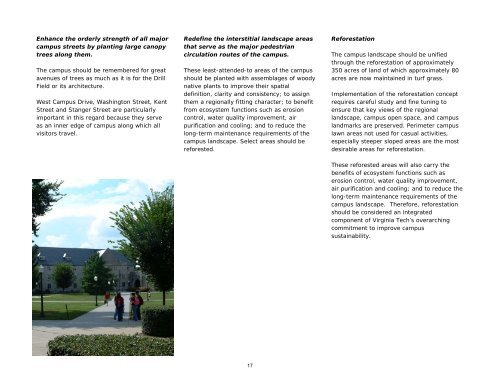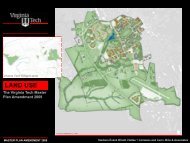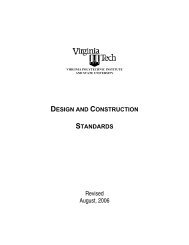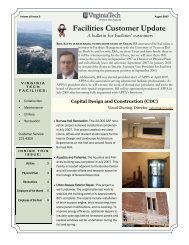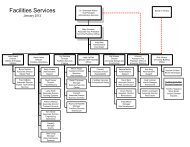Campus Design Principles - Facilities Services - Virginia Tech
Campus Design Principles - Facilities Services - Virginia Tech
Campus Design Principles - Facilities Services - Virginia Tech
You also want an ePaper? Increase the reach of your titles
YUMPU automatically turns print PDFs into web optimized ePapers that Google loves.
Enhance the orderly strength of all major<br />
campus streets by planting large canopy<br />
trees along them.<br />
The campus should be remembered for great<br />
avenues of trees as much as it is for the Drill<br />
Field or its architecture.<br />
West <strong>Campus</strong> Drive, Washington Street, Kent<br />
Street and Stanger Street are particularly<br />
important in this regard because they serve<br />
as an inner edge of campus along which all<br />
visitors travel.<br />
Redefine the interstitial landscape areas<br />
that serve as the major pedestrian<br />
circulation routes of the campus.<br />
These least-attended-to areas of the campus<br />
should be planted with assemblages of woody<br />
native plants to improve their spatial<br />
definition, clarity and consistency; to assign<br />
them a regionally fitting character; to benefit<br />
from ecosystem functions such as erosion<br />
control, water quality improvement, air<br />
purification and cooling; and to reduce the<br />
long-term maintenance requirements of the<br />
campus landscape. Select areas should be<br />
reforested.<br />
Reforestation<br />
The campus landscape should be unified<br />
through the reforestation of approximately<br />
350 acres of land of which approximately 80<br />
acres are now maintained in turf grass.<br />
Implementation of the reforestation concept<br />
requires careful study and fine tuning to<br />
ensure that key views of the regional<br />
landscape, campus open space, and campus<br />
landmarks are preserved. Perimeter campus<br />
lawn areas not used for casual activities,<br />
especially steeper sloped areas are the most<br />
desirable areas for reforestation.<br />
These reforested areas will also carry the<br />
benefits of ecosystem functions such as<br />
erosion control, water quality improvement,<br />
air purification and cooling; and to reduce the<br />
long-term maintenance requirements of the<br />
campus landscape. Therefore, reforestation<br />
should be considered an integrated<br />
component of <strong>Virginia</strong> <strong>Tech</strong>’s overarching<br />
commitment to improve campus<br />
sustainability.<br />
17


